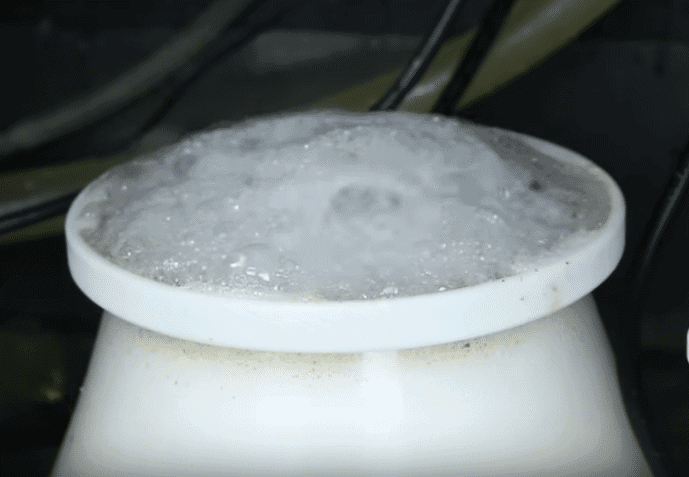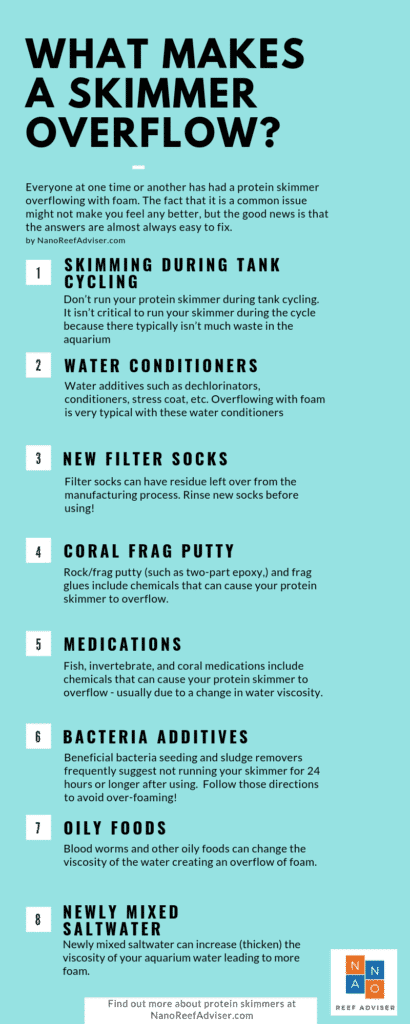Everyone at one time or another has had a protein skimmer overflowing with foam bubbles. The fact that it is a common issue might not make you feel any better, but the good news is that the answers are almost always easy to fix.
What makes a protein skimmer overflow with foam?:
- Break-in Period: The protein skimmer break-in period is typically 2-4 weeks. Skimmers are erratic during the break-in period due to a lack of a biofilm on the skimmer body.
- Protein Skimmer during Tank Cycle: Don’t run your protein skimmer during tank cycling. It isn’t critical to run your skimmer during the cycle because there typically isn’t much waste in the aquarium.
- Water Conditioners: Water additives such as de-chlorinators, conditioners, stress coats, etc. Overflowing with bubbles is very typical with these water conditioners.
- New Filter Socks: Filter socks can have residue leftover from the manufacturing process. Rinse new socks before using them.
- Frag Glue: Rock/frag putty (such as two-part epoxy) and frag glues include chemicals that can cause your protein skimmer to overflow.
- Medications: Fish, invertebrate, and coral medications include chemicals that can cause your protein skimmer to overflow.
- Bacteria Additives: Beneficial bacteria seeding and sludge removers frequently suggest not running your skimmer for 24 hours or longer after using.
- Oily foods: Blood worms and other oily foods can change the water’s viscosity, creating an overflow of bubbles.
- Newly Mixed Saltwater: Can increase (thicken) the viscosity of your aquarium water leading to more foam.
- Internal Water Level: If set too high, the protein skimmer water level will allow the slightest change in your water chemistry to cause your skimmer to overflow.
- Sump Water Level: Set up your protein skimmer at the proper water level. Keep your skimmer properly vented.
- Household chemicals/cleaning solutions: Air fresheners, window cleaners, etc., can change your water chemistry enough to cause an issue.
- Maintenance: Blockages, salt creep, bent hoses, clogged sponges, etc., will all affect the proper operation of your protein skimmer.
Has the protein skimmer broken?
The good news is that your protein skimmer is likely NOT broken. Protein skimmers are a big investment, and replacing one can be a backbreaker financially.
Luckily with nano reef tanks, protein skimmers are not usually more than $200.00. However, that would still be a hard pill to swallow.
Review the checklist of possible contributors above and understand how these changes affect your skimmer’s performance. Adapt to the changes by turning off your skimmer when appropriate to avoid overflowing with foam or excessive foam.
If it turns out you need a new protein skimmer for your nano reef aquarium, I recommend Tunze protein skimmers. It’s what I use in my current tank.
My Tunze is the Comline DOC DC Protein Skimmer 9004. I greatly prefer the DC models. The adjustability afforded by the DC setup is just heads and tails above the AC option.
Protein skimmer overflowing / protein skimmer not bubbling – when all else fails!
You have seen the list of things above that can definitely make your protein skimmer overflow in a foamy mess. What are you to do if you have a firm grasp on managing the issues above, but your skimmer continues to overflow?
If you have double-checked that your skimmer is installed and set up properly and that it has gone through a full break-in period, then the trouble may be that you need to manage your water viscosity.
Skimmer overflowing with foam – Water Viscosity in a Reef Aquarium
If the water is more viscous (thick), the skimmer will foam more as air bubbles stay in the water column and collect. The skimmer will foam less if the water is less viscous (thin).
There are lots of things that will change water viscosity. Essentially a bunch of the stuff in our initial list above will increase the water’s viscosity in your reef tank.
Easy steps to manage water viscosity in a reef tank:
- Thaw and rinse frozen food in RO/DI water and strain the food out of the liquid before feeding.
- If you must use chemical additives from the list above, including medications, dechlorinators, water conditioners, etc., add them in smaller daily amounts instead of large ‘all at once’ amounts.
- Run activated carbon with monthly changes. Run 2x the activated carbon initially during over foaming issue
- Don’t add anything to your reef tank that you don’t have to!
- Rinse filter socks before every use.
- Do more frequent water changes. Make your initial water change to correct over-foaming 25%
- Turn off the skimmer for a few hours after the water changes
If the problem remains or becomes severe after two weeks, perform the following elimination procedure. The goal is to rid the water of whatever is making your protein skimmer overflow. The process takes 1-3 hours but should resolve the overflowing foam in 1 day.
- Have 5-10 gallons of clean saltwater available
- Turn off your Automatic Top Off System.
- Adjust the skimmer so you set the water level inside the skimmer is low, so the skimmate fills the cup slowly.
- Connect the tubing to the skimmer cup drain fitting (at the bottom of the cup) and allow it to drain into a separate container.
- Allow the skimmate foam to overflow from the cup and exit the system through the tubing. The foam will remove whatever is in the water column that is causing your skimmer to overflow.
- To keep the water level consistent, top off your aquarium with the new saltwater as the water level drops.
Protein Skimmer Purpose
The primary purpose of a protein skimmer in a reef aquarium is to remove protein and other organic waste material from the water column.
Another great benefit is that the skimming process heavily oxygenates the water in the skimmer that is returned into the reef tank – improving the gas exchange. The improved gas exchange helps to maintain proper pH by reducing carbon dioxide buildup.
Using your protein skimmer during the cycle: You can leave the cup off during the nitrogen cycle if you want the value of oxygenation without the cup overflowing with foam.
Nano Reef Adviser Tip

Protein Skimmer: How it Works
Protein skimmers use air pushed into water to create a dense bubble mass called foam. This foam mass is carried or pushed up through the skimmer and into a collection cup.
Through a chemical process known as adsorption, protein and organic waste materials in the water stick to the surface of air bubbles. Therefore, when the bubbles are pushed into the collection cup, they carry the organic wastes into the cup with them. This removes the waste from the water column completely.
Removing these wastes from the water allows the mechanical and biological filtration systems to work more efficiently.
Additional Benefits of Protein Skimmers:
In addition to removing organic wastes and improving the gas exchange, protein skimmers have several additional benefits, including:
- Reduces phosphates, which greatly helps protect against nuisance algae growth.
- Reduces biological toxins released from corals, algae, and/or invertebrates.
- It allows you to push the limits a bit with a larger bioload, allowing you to have more tank inhabitants.
- Remove oily surface wastes that can reduce light penetration into your reef tank.
A few quick tips for other typical protein skimmer problems
Protein skimmer not bubbling
If you are not getting bubbles, even though the skimmer appears to be operating fine, then you likely have a blockage in your airline path.
Calcium buildup, salt creep, and other blockages will begin to reduce the foam quality very quickly. Tear down the skimmer sufficiently to allow you to clear the entire airline path through the skimmer.
The airline, venturi, air trap, and air silencer are all susceptible to clogging. Soaking parts in white vinegar for 30 minutes or so does a good job of cleaning.
Protein skimmer releasing bubbles in the tank
There are several reasons why a protein skimmer will create bubbles/microbubbles in your reef tank.
It is typical for skimmers to produce microbubbles during the break-in period. The break-in period can last 2-4 weeks.
Having your skimmer too deep in the sump will affect the skimmer’s performance and produce microbubbles. Buy or DIY-build a skimmer stand ( e.g., egg crate and nylon cable ties) to keep your skimmer at the manufacturer’s recommended depth.
Additionally, if the air to the protein skimmer has been restricted, it can cause the ratio of water to air to increase and push bubbles out of the skimmer’s body. Tear down the skimmer sufficiently to clear the entire airline path through the skimmer. Also, ensure that the internal airline within the skimmer body isn’t kinked.
Protein skimmer low water level
In-sump skimmers require constant water levels to function properly. Verify your water level is set at the manufacturer’s recommended height for your skimmer and that the water level stays consistent.
Protein skimmer collection cup filling with water
A clogged venturi (where air enters the skimmer pump) can lead to the protein skimmer pulling in too much water. Ensure you clean the venturi and clear out any debris and salt/calcium build-up by soaking in white vinegar and clearing the openings. Clean the impeller, airline, and air silencer.
Protein skimmer overflowing after a water change?
Newly mixed salt water can increase the viscosity of the water in your reef tank. Turn off your protein skimmer for a few hours after a water change.
Conclusion:
Everyone at one time or another has had a protein skimmer overflowing with foam bubbles. A great list of things can exacerbate foaming and the overflow of your protein skimmer.
The list essentially comes down to chemicals you add to your reef tank for one reason or another. Don’t add anything that you don’t need to. When you add chemicals, try and add them in small doses (daily?) instead of all at once (weekly?)

Besides improper installation and failure to complete the break-in period, it is often a change to the water viscosity that causes over foaming. Even water changes can change water viscosity enough to create an issue.
Managing your water viscosity may include additional steps, including pre-rinsing and straining frozen foods before feeding or running more activated carbon than usual. Of course, the answer to almost any problem in the reefing community is more frequent water changes.
If everything has been working well and suddenly your protein skimmer starts overflowing with foam? Review this post and ask yourself, what’s changed?
Related Article: Low Maintenance Reef Tank – The Easy Way